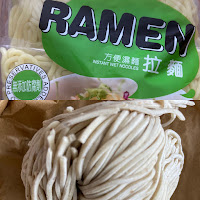Someone mentioned the Japanese TV series Midnight Diner, as a pleasure to watch. I like its bite-sized portraits of the nocturnal diners who visit and enjoy the Master's dishes. The food looks delicious and simple recipes are presented in each episode. Google Midnight Diner Recipes for tens of thousands results for easy, tasty recipes to enjoy at home.
Food to be enjoyed together with friends.
Which is why I was inspired to pick Japanese Comfort Food for an Epitourist theme. I chose ramen, since I so enjoy a bowl of the rich broth.
Turns out this 'simple' meal is quite complex. What I had thought would be a fairly easy dish to prepare is a multi-day affair. Looking up recipes, it didn't take long to become daunted by the advice of ramen chefs and the multiple processes involved.
It did seem a bit overwhelming.
- Where to get ingredients like dashi, kelp, bonito flakes, pork necks?
- What about the different ramen broths? Was there really a difference?
- What is tare? How do shoyu, shio, and miso tares differ?
- How to best prepare fresh noodles, chashu (pork), Ramen eggs?
- How does it all come together in the perfect bowl?
Like any journey, this began with a first step. To J-Town and the Japanese grocery, where I was able to pick up the dried kelp and bonito flakes. The Chinese grocery on Gerrard had the chicken carcasses and pork necks at very good prices.
Two different sources helped guide me through the process, where deep consideration is provided to every ingredient.
- Seonkyoung Longest, The Best Ramen Recipe
- Shihoko, Chopstick Chronicles, Homemade Ramen Broth Recipe – Rich Flavoured
I decided to make three different ramen broths so I could taste the difference between them. While preparing the broths I was surprised that there was absolutely no salt added. Also, after the bones were boiled and initially blanched, the water was discarded to get rid of distasteful elements like blood and seek a 'cleaner' taste. The bones are then boiled for hours in the aromatics, producing rich and flavourful results. The stocks bubbled and thickened and shimmered and I sampled them as they improved in taste and texture. When cooled, the stocks jiggled with all the collagen.
There were two different methods for cooking the pork belly for chashu. One in the stock, one in a separate pot. I went the route Shihoko recommended with a separate pot, boiling the meat for one hour without any seasoning, then discarding the water and boiling again in the marinade of soy sauce, sake, sugar and honey - avoiding any mirin due to its tightening effect. After another hour boiling, the meat can stay overnight in the sauce to absorb additional flavours. The next day, the chashu sauce can be reduced for the tare and the meat thinly sliced to be ready for assembly.
The Ramen Eggs or Ajitsuke Tamago, are also prepared ahead: soft boiled and then marinaded overnight in soy sauce, sake, and mirin.
Rob and I invited Liz and Darcy for dinner to debut my first attempt at making ramen. Curious, I designed a tasting presentation to compare the different broths and tares so our palates could compare them, and so we could also confer with each other's palates.
We had a few different options for the noodles themselves. After all the effort that went into the other ingredients, it seemed a shame to use prepackaged instant noodles, so Rob picked up some fresh frozen from Bare Market on the Danforth.
Onto the tasting........
There was definitely a difference between the broths: chicken; chicken with Japanese dashi; and tonkotsu (pork bones). They were all seriously good! Tonkotsu to me had a sweetness to it, the chicken with Japanese dashi had more flavour from the sea. Both Tonkotsu and dashi stocks had lip smacking umami.
The tares (also made ahead) were quite distinct from one another, but all had green onion, garlic and ginger as common aromatics. I laid them on the table so we could each choose what we wanted in our ramen bowls.
- shio (dashi of kelp, bonito flake, shitaki mushroom + sake + miren). no soy sauce so a clear tare, but still quite salty
- reduced chashu sauce (no mirin, but otherwise shoyu flavours)
- shoyu (soy sauce, mirin, sake)
- miso (miso, peanutbutter, scallion)
Liz, Darcy and Rob all chose the reduced chashu tare, I picked the miso.
Then it was off to the kitchen to assemble the ramen bowls. Everything was ready to go but the last minute blanching of the sprouts and the cooking of the ramen noodles. Tare in the bottom of the bowl, followed by the broth, then the noodles, then the blanched sprouts, sliced chashu, Ramen egg, and a generous handful of spring onion. Lesson learned: the sequence is important! Also, try not to forget the freshly grated garlic on top.
The bowls were brought to the table and we all enjoyed slurping the noodles and savouring the pork. Chilled Nigori sake served alongside.
The days spent preparing the meal added to its anticipation, and I truly enjoyed every mouthful. I hope our guests enjoyed this 'simple' meal as much as I did!
The next day for lunch, Rob and I tried the Tonkotsu broth with miso tare, chashu, and soft boiled egg. Another delicious combination.
I froze a little of the chicken-dashi broth so I could prepare a similar tasting for the Epitourists in April. I can understand why there are so many self-confessed Ramen Nerds on the planet! There's even a Facebook group for Hardcore Ramen Nerds.





No comments:
Post a Comment